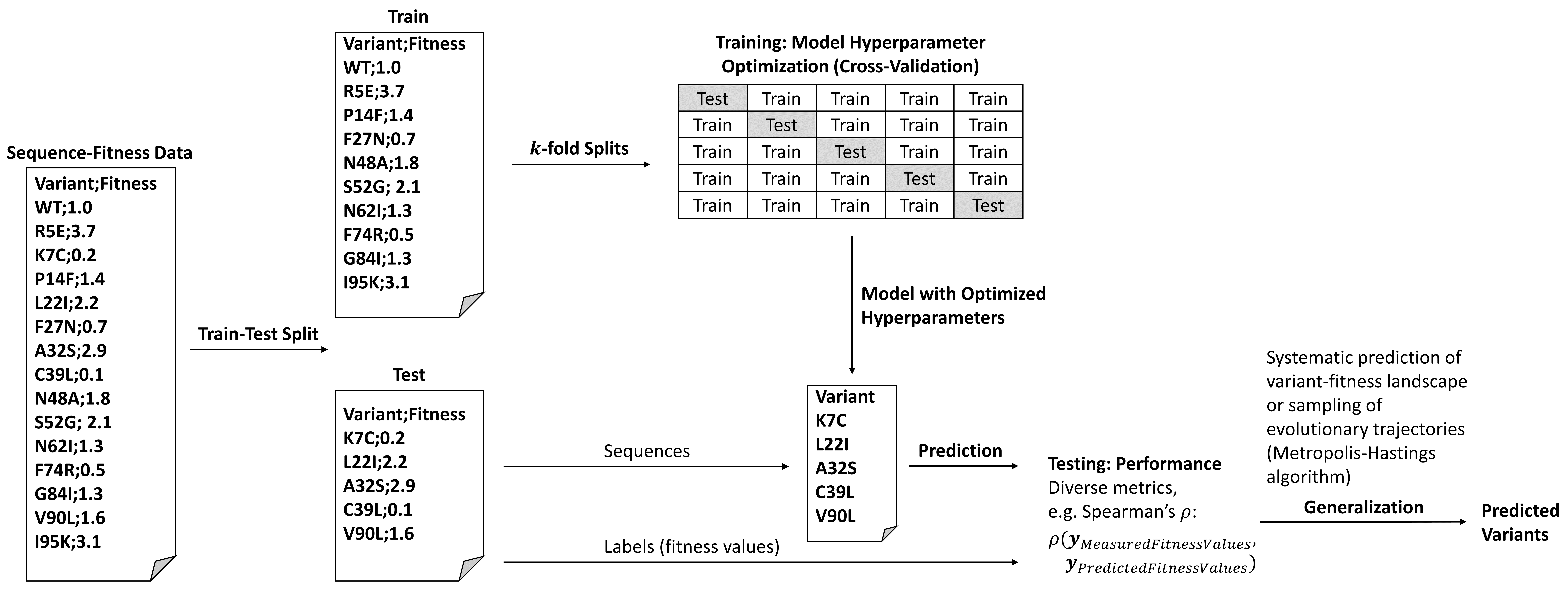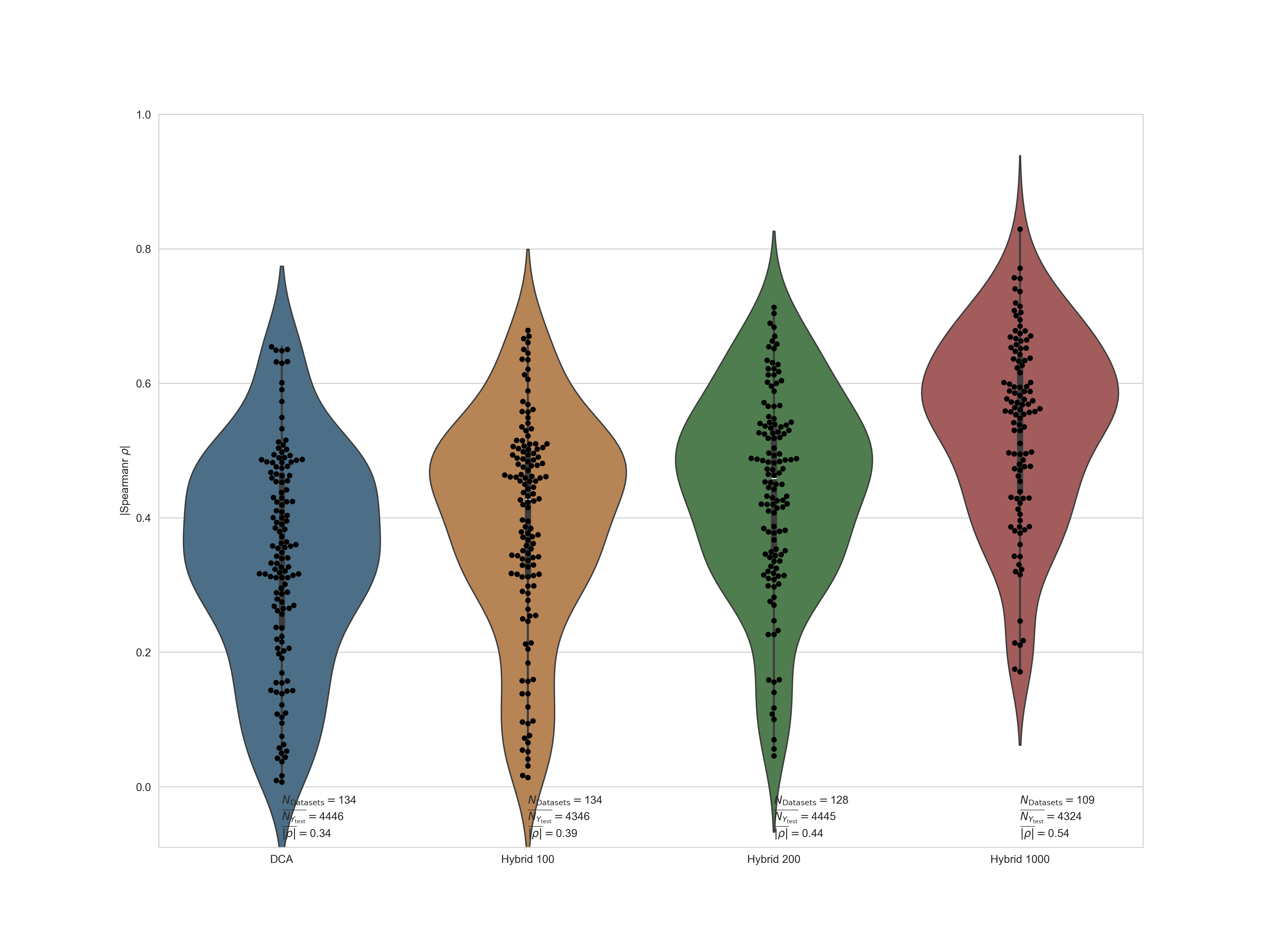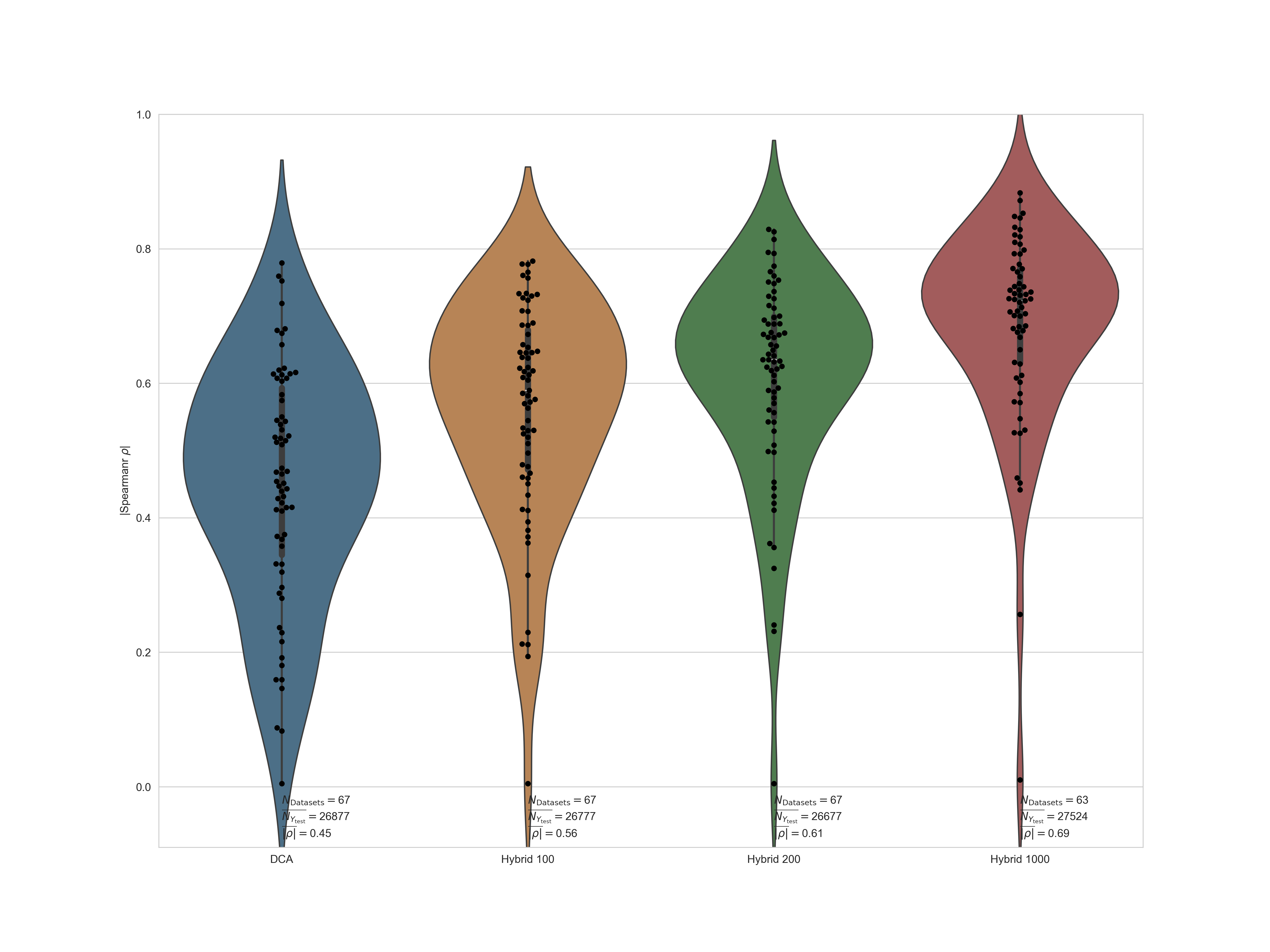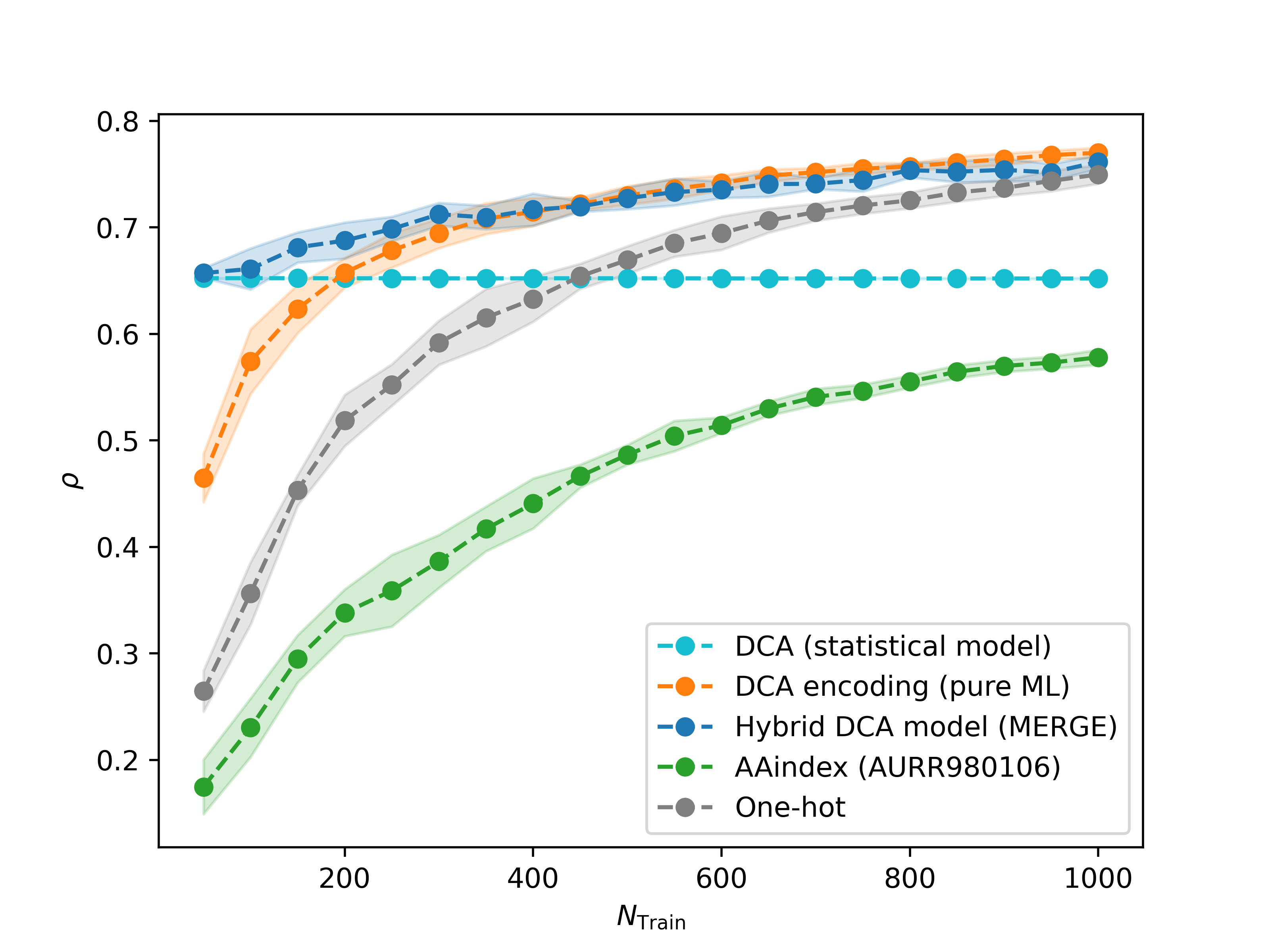A command-line interface (CLI) tool for performing data-driven protein engineering by building machine learning (ML)-trained regression models from sequence variant fitness data (in CSV format) based on different techniques for protein sequence encoding. Next to building pure ML models, "hybrid modeling" is also possible using a blended model optimized for predictive contributions of a statistical and an ML-based prediction.
Project description
This repository contains the source files and supplementary information for the PyPEF framework, which is described in
Niklas E. Siedhoff1,§, Alexander-Maurice Illig1,§, Ulrich Schwaneberg1,2, Mehdi D. Davari3,*,
PyPEF – An Integrated Framework for Data-Driven Protein Engineering,
J. Chem. Inf. Model. 2021, 61, 3463-3476
https://doi.org/10.1021/acs.jcim.1c00099
as well as additional framework features described in the preprint
Alexander-Maurice Illig1,§, Niklas E. Siedhoff1,§, Ulrich Schwaneberg1,2, Mehdi D. Davari3,*,
A hybrid model combining evolutionary probability and machine learning leverages data-driven protein engineering,
preprint available at bioRxiv: https://doi.org/10.1101/2022.06.07.495081
now published as
Evolutionary Probability and Stacked Regressions Enable Data-Driven Protein Engineering with Minimized Experimental Effort,
J. Chem. Inf. Model. 2024, 64, 16, 6350–6360
https://doi.org/10.1021/acs.jcim.4c00704
1Institute of Biotechnology, RWTH Aachen University, Worringer Weg 3, 52074 Aachen, Germany
2DWI-Leibniz Institute for Interactive Materials, Forckenbeckstraße 50, 52074 Aachen, Germany
3Department of Bioorganic Chemistry, Leibniz Institute of Plant Biochemistry, Weinberg 3, 06120 Halle, Germany
*Corresponding author
§Equal contribution
Table of Contents
PyPEF: Pythonic Protein Engineering Framework
- Quick Installation
- Requirements
- Running Examples
- Tutorial
- Encoding Technique Options
- Modeling Techniques
- Model Hyperparameter Grids for Training
- Setting Up the Scripts Yourself
- Preprocessing for DCA-based Sequence Encoding
- Unsupervised/zero-shot prediction
- API Usage for Sequence Encoding
PyPEF: Pythonic Protein Engineering Framework
a framework written in Python 3 for performing sequence-based machine learning-assisted protein engineering to predict a protein's fitness from its sequence using different forms of sequence encoding:
- One-hot encoding
- Amino acid descriptor sets (taken from AAindex database) encoding
- Direct coupling analysis (amino acid coevolution based on multiple sequence alignments) encoding
Written by Niklas Siedhoff and Alexander-Maurice Illig.

Protein engineering by rational or random approaches generates data that can aid the construction of self-learned sequence-function landscapes to predict beneficial variants by using probabilistic methods that can screen the unexplored sequence space with uncertainty in silico. Such predictive methods can be applied for increasing the success/effectivity of an engineering campaign while partly offering the prospect to reveal (higher-order) epistatic effects. Here we present an engineering framework termed PyPEF for assisting the supervised training and testing of regression models for predicting beneficial combinations of (identified) amino acid substitutions using machine learning algorithms from the Scikit-learn package. As training input, the developed framework requires the variant sequences and the corresponding screening results (fitness labels) of the identified variants as CSV (or FASTA-Like (FASL) datasets following a self-defined convention). Using linear or nonlinear regression methods (partial least squares (PLS), Ridge, Lasso, Elastic net, support vector machines (SVR), random forest (RF), and multilayer perceptron (MLP)-based regression), PyPEF trains on the given learning data while optimizing model hyperparameters (default: five-fold cross-validation) and can compute model performances on left-out test data. As sequences are encoded using amino acid descriptor sets taken from the AAindex database, finding the best index-dependent encoding for a specific test set can be seen as a hyperparameter search on the test set. In addition, one-hot and direct coupling analysis-based feature generation are implemented as sequence encoding techniques, which often outperform AAindex-based encoding techniques. Finally, the selected or best identified encoding technique and regression model can be used to perform directed evolution walks in silico (see Church-lab implementation or the reimplementation) or to predict natural diverse or recombinant variant sequences that subsequently are to be designed and validated in the wet-lab.
For detailed information, please refer to the above-mentioned publications and related Supporting Information.
The workflow procedure is explained in the Jupyter notebook (.ipynb) protocol (see Tutorial section below).

Quick Installation
A quick installation of the PyPEF command line framework using PyPI for Linux and Windows and Python >= 3.9 can be performed with:
pip install -U pypef
After successful installation, PyPEF should work by calling pypef in the shell:
pypef --help
The detailed routine for setting up a new virtual environment with Anaconda, installing the necessary Python packages for that environment, and running the Jupyter notebook tutorial can be found below in the Tutorial section. A quick file setup and run test can be performed running files in scripts/Setup containing a Batch script for Windows and a Bash script for Linux (the latter requires conda, i.e. Miniconda3 or Anaconda3, already being installed).
Requirements
- Python >=3.9
- numpy
- scipy
- pandas
- scikit-learn
- scikit-learn-intelex
- tensorflow
- ray[default]
- matplotlib
- tqdm
- biopython
- schema
- docopt
- adjustText
If errors occur with third-party packages, you can check the required Python version dependencies (if available); also, as a rule of thumb, it is often helpful to use the second most recent Python version instead of the latest, since development for the latest version is often ongoing:
Running Examples
Printing the help function:
pypef --help
Creating sets for model learning and testing:
pypef mklsts -w WT_SEQUENCE.FASTA -i VARIANT-FITNESS_DATA.CSV
Training and testing a model (encoding technique = {aaidx, onehot, dca}, regression model = {pls, ridge, lasso, elasticnet, svr, rf, mlp}):
pypef ml -e aaidx -l LEARNING_SET.FASL -t TEST_SET.FASL --regressor pls
Show the model performance(s) (reads and prints the created Model_Results.txt file):
pypef ml --show
Load a trained model, predict fitness of test sequences using that model, and plot the measured versus the predicted fitness values:
pypef ml -e aaidx -m MODEL -t TEST_SET.FASL
-m MODELis the saved model Pickle file name, for -e aaidx this will be the AAindex to use for encoding, e.g. -m ARGP820101, for -e onehot it will be -m ONEHOTMODEL and for -e dca it will be -m DCAMODEL.
Load a trained model and use it for predicting the fitness of sequences of a prediction set (with unknown corresponding fitness):
pypef ml -e aaidx -m MODEL -p PREDICTION_SET.FASTA
Systematic creation of prediction sets – double, triple, or quadruple substituted variant recombinations of already identified amino acid substitutions (--drecomb, --trecomb, --qarecomb, --qirecomb) or naturally diverse combinations of all 20 canonical amino acids at the identified positions (--ddiverse, --tdiverse, --qdiverse):
pypef mkps -w WT_SEQUENCE.FASTA -i VARIANT-FITNESS_DATA.CSV --drecomb
Systematic prediction of the created (re)combination prediction sets:
pypef ml -e aaidx -m MODEL --pmult --drecomb
An alternative way of prediction and variant identification is the in silico directed evolution using the Metropolis-Hastings algorithm:
pypef directevo ml -e -m MODEL -w WT_SEQUENCE.FASTA --usecsv -i VARIANT-FITNESS_DATA.CSV --ywt WT_FITNESS
Encoding a variant-fitness CSV file and writing it to a new CSV file (for the different encodings, also specify the AAindex name with the -m option next to -e aaidx):
pypef encode -i VARIANT-FITNESS_DATA.CSV -w WT_SEQUENCE.FASTA -e aaidx
Using the created variant-encoded sequence-fitness CSV file for a simulated "low N" engineering task:
pypef ml low_n -i VARIANT-FITNESS-ENCODING_DATA.CSV --regressor pls
Using the created variant-encoded sequence-fitness CSV file for a simulated "mutation extrapolation" task (requires higher/deeply-substituted variants):
pypef ml extrapolation -i VARIANT-FITNESS-ENCODING_DATA.CSV --regressor pls
The use of the hybrid model (pypef hybrid) - instead of a pure ML model (pypef ml) as described in the steps above - is quite similar in terms of commands, but does not require the definition of the -e/--encoding and the --regressor flags, since it depends only on the DCA-based encoding technique and (so far) only uses Ridge regression for modeling. However, DCA-based encoding of sequences always requires a parameter file as input, which comes from the preprocessing of a query-specific multiple sequence alignment (MSA) and results in the parameter file generated by plmc. E.g. for training a model on a learning set and testing it on a test set, the command for hybrid modeling is:
pypef hybrid -l LEARNING_SET.FASL -t TEST_SET.FASL --params PLMC_FILE.params
Also, it is now possible to infer DCA model parameters using GREMLIN's TensorFlow implementation and a generated MSA in FASTA or A2M format:
pypef param_inference --msa MSA.fasta -w WT_SEQUENCE.FASTA --opt_iter 250
For getting coupling information and highly evolved amino acids:
pypef save_msa_info --msa MSA.fasta -w WT_SEQUENCE.FASTA --opt_iter 250
Using saved GREMLIN model for testing:
pypef hybrid -l LEARNING_SET.FASL -t TEST_SET.FASL --params GREMLIN
Sample files for testing PyPEF routines are provided in the workflow directory, which are also used when running the notebook tutorial. PyPEF's package dependencies are linked here. Further, for designing your own API based on the PyPEF workflow, modules can be adapted from the source code.
As standard input files, PyPEF requires the target protein wild-type sequence in FASTA format and variant-fitness data in CSV format to split the collected variant-fitness data in learning and test sets that resemble the aligned FASTA format and additionally contain lines indicating the fitness of each corresponding variant (see ANEH sample files, avGFP sample files, and MERGE SSM & DMS files).
Tutorial
Before starting running the tutorial, it is a good idea to set up a new Python environment using Anaconda, https://www.anaconda.com/, e.g. using Anaconda (Anaconda3-2023.03-1-Linux-x86_64.sh installer download) or Miniconda. Change to the download directory and run the installation, e.g. in Linux:
bash Anaconda3-2023.03-1-Linux-x86_64.sh
After accepting all steps, the conda setup should also be written to your ~/.bashrcfile, so that you can call anaconda typing conda.
Next, to download this repository click Code > Download ZIP and unzip the zipped file, e.g. with unzip PyPEF-main.zip, or just clone this repository using your bash shell to your local machine git clone https://github.com/niklases/PyPEF.
To set up a new environment with conda you can either create the conda environment from the provided YAML file inside the PyPEF directory (cd PyPEF or cd PyPEF-main dependent on the downloaded file name and chose YAML file for your operating system):
conda env create --file linux_env.yml
or you can create a new environment yourself. You just need to specify the name of the environment and the Python version, e.g.:
conda create --name pypef python=3.10
To activate the environment you can define:
conda activate pypef
After activating the environment you can install required packages after changing the directory to the PyPEF directory (cd PyPEF or cd PyPEF-main) and install required packages with pip if you did not use the YAML file for creating the environment (if using conda, packages will be installed in anaconda3/envs/pypef/lib/python3.10/site-packages):
python3 -m pip install -r requirements.txt
Note that the package Ray which we use for parallelizing sequence encoding and model validation of AAindices on the test set, is in beta status for Windows.
Now, after installing required packages, you should be able to directly run pypef in the command-line interface.
To run the tutorial after installing required packages either from the conda YAML environment file, the TEXT requirement file, or after installing packages using the pip version of PyPEF, open a Jupyter notebook. If you have installed Anaconda, Jupyter notebook and other commonly used packages for scientific computing and data science should be already installed in Python. If not, you can also install Jupyter via python3 -m pip install ipython jupyter. To use the pypef environment as a specified kernel inside the Jupyter notebook, you need to install ipykernel and set the kernel name:
python3 -m pip install ipykernel jupyter
python3 -m ipykernel install --user --name=pypef
Now change the directory to ./scripts/CLI (cd scripts/CLI) and run the .ipynb file (after downloading the files it might be necessary to make the script executable first: chmod +x Workflow_PyPEF.ipynb):
jupyter-notebook
Copy the notebook URL in your internet browser and select the Workflow_PyPEF.ipynb file to open it. Now you can select the pypef Python environment at the top notebook menu: Kernel > Change kernel > pypef (otherwise you would use your default Python version as environment, i.e. you would have to install the required packages for this interpreter as well; for this case the installation of the prerequisite packages can also be done within the notebook in provided code fields).
Encoding Technique Options
-
AAindex: Sequence encoding based on AAindex descriptor sets; e.g. using AAindex https://www.genome.jp/entry/aaindex:ARGP820101 for encoding and without subsequent fast Fourier transform (FFT) of the encoded sequence:
sequence 'MKLLF' --> [1.18, 1.15, 1.53, 1.53, 2.02]
and with FFT of the encoded sequence:
sequence 'MKLLF' --> [0.0000, 1.0000, 0.1435, 0.3010] -
OneHot: Occurence of a specific amino acid at a specific residue position indicated as a 1 and else as a 0:
sequence 'MKLLF' -->
[ 0, 0, 0, 0, 0, 0, 0, 0, 0, 0, 1, 0, 0, 0, 0, 0, 0, 0, 0, 0,
0, 0, 0, 0, 0, 0, 0, 0, 1, 0, 0, 0, 0, 0, 0, 0, 0, 0, 0, 0,
0, 0, 0, 0, 0, 0, 0, 0, 0, 1, 0, 0, 0, 0, 0, 0, 0, 0, 0, 0,
0, 0, 0, 0, 0, 0, 0, 0, 0, 1, 0, 0, 0, 0, 0, 0, 0, 0, 0, 0,
0, 0, 0, 0, 1, 0, 0, 0, 0, 0, 0, 0, 0, 0, 0, 0, 0, 0, 0, 0 ] -
DCA: Direct coupling analysis of multiple sequence alignments to extract evolutionary query-specific features. DCA-based features will be generated from the local and coupling terms of the parameter file (paramfile) output by plmc for each target variant sequence. This encoding technique generally outperforms the other encoding techniques described here, but depends on finding and aligning a minimum set of evolutionarily related/homologous sequences - which is not possible for every target sequence. Preprocessing steps for generating the paramfile based on a target sequence are described in the hybrid model repository. Unlike the other encoding techniques presented, this evolution-based encoding technique is system-specific rather than amino acid-specific, i.e. it does not treat each amino acid the same, but according to its evolutionary position- and coupling-specific history. The DCA-based encoding technique is further also provided for constructing a pure ML model:
sequence 'MKLLF' --> [2.3445, 1.3294, 1.6245, 0.8901, 3.2317] , while
sequence 'MKLKF' --> [2.3472, 1.3601, 1.5431, 1.3749, 3.0186] .
Modeling Techniques
Pure Machine Learning (ML)-based Modeling
Several linear and non-linear modeling options are available by default to construct supervised regression models based on the generated sequence features, i.e. encoded sequences. Regression models are trained, i.e. model hyperparameters are optimized, by k- fold (by default, fivefold) cross-validation on training samples. Here, the model aims to map the encoded variant sequences that are the features (X) for predicting the corresponding fitness labels (y) such that f(X) --> y – while cross-validation and/or using a model implementing a penalty will be necessary for better model generalization behavior. Following regression options from Scikit-learn are implemented (for optimized hyperparameters, see Model Hyperparameters section below):
- Partial Least Squares Regression (linear model)
- Lasso Regression (fit with Least Angle Regression, L1-penalty regularized linear model)
- Ridge Regression (L2-penalty regularized linear model)
- ElasticNet Regression (combined L1- and L2-penalty regularized linear model)
- Support Vector Machines Regression (nonlinear model)
- Random Forest Regression (nonlinear ensemble model)
- Multilayer-Perceptron Regression ("Deep" learning with a single hidden layer, nonlinear model)
Hybrid Modeling Using the MERGE Method
Optimization of the two model contributions to the final hybrid model using the differential evolution algorithm (see the hybrid model preprint and the corresponding repository of the method termed MERGE); only based on DCA-derived features (therefore no definition of the flag -e, --encoding necessary for hybrid modeling):
- DCA-based statistical prediction of the evolutionary energy, i.e., probability, of a variant relative to the wild type (see EVmutation; EVmutation repository/EVcouplings repository).
- ML-based supervised training with Ridge regression on training subsets of DCA-encoded sequences and the corresponding fitness values (similar to the pure ML approach using the DCA-based encoding technique in combination with Ridge regression)
Model Hyperparameter Grids for Training
The following model hyperparameter ranges are tested during (k-fold) cross-validation for optimized model generalization:
| Regression model | Hyperparameter grid |
|---|---|
| PLS | N_components= {1, 2, 3, ..., 9} |
| Ridge | regularization param. = {1.000E-06, 1.322E-06, 1.748E-06, ..., 1.000E06} (numpy.logspace(-6, 6, 100)) |
| LassoLars | regularization param. = {1.000E-06, 1.322E-06, 1.748E-06, ..., 1.000E06} (numpy.logspace(-6, 6, 100)) |
| ElasticNet | regularization param. = {1.000E-06, 1.322E-06, 1.748E-06, ..., 1.000E06} (numpy.logspace(-6, 6, 100)) |
| SVR | regularization param. = {2^0, 2^2, 2^4, 2^6, 2^8, 2^10, 2^12}, kernel coefficient = {1E−01, 1E−02, 1E−03, 1E−04, 1E−05} |
| RF | N_trees = {100, 250, 500, 1000}, max. features = {all features, sqrt(all features), log2(all features)} |
| MLP | single hidden layer size = {1, 2, ..., 12}, solver = {ADAM, L-BFGS}, initial learning rate = {0.001, 0.01, 0.1} |
Setting Up the Scripts Yourself
PyPEF was developed to be run from a command-line interface while python3 ./pypef/main.py (when using the downloaded version of this repository and setting the PYTHONPATH) is equal to pypef when installed with pip.
Downloading/cloning the repository files (manually or with wget/git clone):
wget https://github.com/niklases/PyPEF/archive/main.zip
Unzipping the zipped file (manually or e.g. with unzip):
unzip main.zip
Setting the PYTHONPATH (so that no import errors occur stating that the package pypef and thus dependent absolute imports are unknown):
Windows (example path, PowerShell)
$env:PYTHONPATH="C:\Users\name\path\to\PyPEF-main"
Linux (example path)
export PYTHONPATH="${PYTHONPATH}:/home/name/path/to/PyPEF-main"
Installing the requirements:
Windows (PowerShell)
python -m pip install -r requirements.txt
Linux
python3 -m pip install -r requirements.txt
Running the main script (from PyPEF-main directory):
Windows (PowerShell)
python .\pypef\main.py
Linux
python3 ./pypef/main.py
Preprocessing for DCA-based Sequence Encoding
-
Downloading sequence database (e.g. UniRef100):
wget https://ftp.uniprot.org/pub/databases/uniprot/uniref/uniref100/uniref100.fasta.gz -
Extracting sequence database:
gunzip uniref100.fasta.gz -
After installing jackhmmer as part of the HMMER package, construct an MSA for your target sequence provided in FASTA format (and for example set
--incTto half the sequence length (0.5L) and the number of used CPUs for computing):jackhmmer --incT 199 --cpu 16 --noali -A ANEH_jhmmer.sto Sequence_WT_ANEH.fasta /path/to/uniref100.fasta -
Convert the created MSA from Stockholm (.sto) format to A2M format:
pypef sto2a2m --sto ANEH_jhmmer.sto -
Now you can follow approaches 5.1 (using GREMLIN; implemented in TensorFlow) or 5.2 (using plmc; extern parameter generation in C).
5.1. Running GREMLIN on the generated MSA (in FASTA or A2M format):
pypef param_inference --msa ANEH_jhmmer.a2m -w WT_SEQUENCE.FASTA --opt_iter 250The pickled GREMLIN file can then be used for encoding new/test sequences:
pypef ml -e dca -l LS.fasl -t TS.fasl --regressor pls --params GREMLINOr for hybrid modeling:
pypef hybrid -l LS.fasl -t TS.fasl --params GREMLIN5.2 After installing plmc, generate the evolutionary coupling file, which is used for encoding sequences. For example, set
-leto the value output bysto2a2m:plmc -o ANEH_72.6.params -le 72.6 -m 100 -g -f WT_ANEH ANEH_jhmmer.a2mThe output parameter (.params) file can be used for encoding sequences with the DCA-based encoding technique (
-e dca) by providing it to PyPEF; e.g. for pure ML modeling:pypef ml -e dca -l LS.fasl -t TS.fasl --regressor pls --params ANEH_72.6.paramsOr for hybrid modeling:
pypef hybrid -l LS.fasl -t TS.fasl --params ANEH_72.6.params
Unsupervised/zero-shot prediction
Several developed methods allow unsupervised prediction of a proteins fitness based on its sequence (and/or structure).
These methods have the advantage that no initial knowledge about a proteins fitness is required for prediction, while a correlation of the predicted score and a protein's natural fitness is assumed.
DCA itself is a statistical/unsupervised method based on MSA information that outperforms simpler MSA-based methods (such as (un)coupled raw MSA sequence frequencies or BLOSUM scores), e.g., see scripts/GREMLIN_numba/using_gremlin_functionalities.ipynb.
To make zero-shot predictions using PyPEF (plmc-DCA or GREMLIN-DCA) just do not provide a training set (no -l flag, only a -t or -p flag) for hybrid modeling, e.g., for the avGFP data, try
pypef param_inference --msa uref100_avgfp_jhmmer_119.a2m
pypef hybrid -t TS.fasl --params GREMLIN
pypef hybrid -p PS.fasta --params GREMLIN
using the GREMLIN parameters, or,
pypef param_inference --params uref100_avgfp_jhmmer_119_plmc_42.6.params
pypef hybrid -t TS.fasl --params PLMC
pypef hybrid -p PS.fasta --params PLMC
using the plmc parameters.
Other well-performing zero-shot prediction methods with available source code are:
- ESM-1v/ESM-2 (https://github.com/facebookresearch/esm)
- ProteinMPNN (https://github.com/dauparas/ProteinMPNN)
- DeepSequence (https://github.com/debbiemarkslab/DeepSequence)
- EVcouplings (plmc-DCA, https://github.com/debbiemarkslab/EVcouplings)
- EVE (https://github.com/OATML/EVE)
- Tranception (https://github.com/OATML-Markslab/Tranception)
- VESPA (https://github.com/Rostlab/VESPA)
This list is by no means complete, see ProteinGym repository and website for a more detailed overview of available methods and achieved performances (as well as for getting many benchmark data sets).
The performance of the GREMLIN model used is shown in the following for predicting
(I) single substitution effects (blue), including Hybrid model performances with N_Train = {100, 200, 1000} (orange, green, and red, respectively)


(II) multi-substitution effects (blue), including Hybrid model performances with N_Train = {100, 200, 1000} (orange, green, and red, respectively)


for ProteinGym datasets computed using the scripts located at scripts/ProteinGym_runs.
API Usage for Sequence Encoding
For script-based encoding of sequences using PyPEF and the available AAindex-, OneHot- or DCA-based techniques, the classes and corresponding functions can be imported, i.e. OneHotEncoding, AAIndexEncoding, GREMLIN (DCA), PLMC (DCA), and DCAHybridModel. In addition, implemented functions for CV-based tuning of regression models can be used to train and validate models, eventually deriving them to obtain performances on retained data for testing. An exemplary script and a Jupyter notebook for CV-based (low-N) tuning of models and using them for testing is provided at scripts/Encoding_low_N/api_encoding_train_test.py and scripts/Encoding_low_N/api_encoding_train_test.ipynb, respectively.

Project details
Release history Release notifications | RSS feed
Download files
Download the file for your platform. If you're not sure which to choose, learn more about installing packages.
Source Distribution
Built Distribution
File details
Details for the file pypef-0.3.6.tar.gz.
File metadata
- Download URL: pypef-0.3.6.tar.gz
- Upload date:
- Size: 265.8 kB
- Tags: Source
- Uploaded using Trusted Publishing? No
- Uploaded via: twine/3.8.0 colorama/0.4.4 importlib-metadata/4.6.4 keyring/23.5.0 pkginfo/1.8.2 readme-renderer/34.0 requests-toolbelt/0.9.1 requests/2.25.1 rfc3986/1.5.0 tqdm/4.57.0 urllib3/1.26.5 CPython/3.10.12
File hashes
| Algorithm | Hash digest | |
|---|---|---|
| SHA256 | 277a9757fb5967fec614e45ea125b9c997f3f80525ab8cb82fd767e1f98b04f3 |
|
| MD5 | a75d47b6c185c935eb6b1178e3dea5d0 |
|
| BLAKE2b-256 | 333854fb1a7413a04479a6b2aae8f08656cd8eaab2945c2f1be36cec44d069b0 |
File details
Details for the file pypef-0.3.6-py3-none-any.whl.
File metadata
- Download URL: pypef-0.3.6-py3-none-any.whl
- Upload date:
- Size: 502.5 kB
- Tags: Python 3
- Uploaded using Trusted Publishing? No
- Uploaded via: twine/3.8.0 colorama/0.4.4 importlib-metadata/4.6.4 keyring/23.5.0 pkginfo/1.8.2 readme-renderer/34.0 requests-toolbelt/0.9.1 requests/2.25.1 rfc3986/1.5.0 tqdm/4.57.0 urllib3/1.26.5 CPython/3.10.12
File hashes
| Algorithm | Hash digest | |
|---|---|---|
| SHA256 | b363044641697d6cc4556a641a4cd44db09093b4a6e0019971012be89ff78c0e |
|
| MD5 | 4ae41384352f28f0cff4fb7f892a8731 |
|
| BLAKE2b-256 | 9960e26b478c60e0f1c46cbcc143ff85b1e1694f294349c086b3b2967ceb6b19 |



























